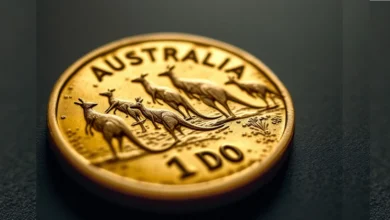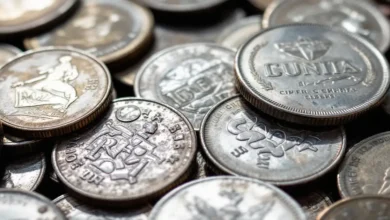The Complete Guide to the 1984 $1 Coin: Value, History, and Collectability

Introduction
The 1984 $1 coin has intrigued collectors and enthusiasts for decades, becoming a topic of interest for both casual coin holders and seasoned numismatists. Although the U.S. Mint did not officially release a one-dollar coin in 1984, many questions surrounding coins from this year still abound, as do possible foreign dollar coins and commemorative tokens bearing the 1984 date. This article aims to clarify the significance, history, and collectability of the so-called 1984 $1 coin, focusing on its role in coin collecting, the nuances of U.S. dollar coins from the late 20th century, and other potential sources for a 1984-marked dollar coin.
This article provides a complete overview of the topic, detailing the Susan B. Anthony dollar series, foreign dollar coins from 1984, and the collectible nature of 1984-dated coins, ensuring you have all the insights to make an informed decision about adding it to your collection.
1. Historical Context of U.S. Dollar Coins (1971-1984)
The history of the one-dollar coin in the United States is complex, particularly from 1971 to the mid-1980s. This period saw fluctuating public interest, design changes, and eventually, a halt in production. Let’s break down the major events during this era.
a) The Eisenhower Dollar (1971-1978)
The U.S. Mint began issuing the Eisenhower dollar coin in 1971 to commemorate President Dwight D. Eisenhower and the Apollo 11 moon landing. The coin was popular for its large size and design but quickly fell out of favor due to its bulky weight. Despite being unpopular in circulation, it retained popularity among collectors, and its design became iconic.
b) The Introduction of the Susan B. Anthony Dollar (1979-1981)
In 1979, the U.S. Mint introduced a new dollar coin featuring Susan B. Anthony, the first real attempt to modernize the dollar coin for circulation. Despite high hopes for a more practical coin, the Anthony dollar faced similar issues with public acceptance. Its small size, close in diameter to the quarter, confused people, leading to minimal circulation and general disinterest.
c) No Dollar Coin in 1984
The US Mint officially halted the production of dollar coins following the 1981 issuance of the Susan B. Anthony dollar, meaning that no official U.S. dollar coins were minted in 1984. However, in 1999, there was a resurgence of interest, and the Mint reissued the Susan B. Anthony dollar to fulfil demand, bringing the series to a close.
d) Foreign Coins and Commemorative Tokens with 1984 Dates
The absence of a U.S. dollar coin for 1984 leaves a gap in American coinage. However, collectors sometimes encounter coins or tokens from other countries with the 1984 date, particularly those from Canada, Australia, or other nations that issued commemorative dollar coins. These can carry value and interest based on their historical or cultural significance.
2. Identifying 1984 Coins: Key Factors
To determine if you’re dealing with a U.S. dollar coin or a foreign issue from 1984, you should examine several features. Here are key identifiers:
a) Design Elements
- Susan B. Anthony Portrait: If the coin bears Anthony’s image, it may be from the 1979-1981 or 1999 U.S. minting period rather than 1984.
- Foreign Symbols or Images: Coins with distinct national emblems, like the Canadian maple leaf or the Australian kangaroo, are clues that they are foreign dollars.
- Color and Metal: U.S. dollar coins from this era were made primarily from copper-nickel clad, while many foreign coins use different materials, including silver or unique alloys.
b) Mint Mark and Date
An authentic 1984 dollar coin from the U.S. Mint does not exist, but foreign coins bearing this date may hold value in specific markets.
3. The Susan B. Anthony Dollar Coin: A Legacy Coin
The Susan B. Anthony dollar, introduced in 1979, was the first U.S. coin to feature a woman’s portrait. This coin commemorated Anthony’s role in the American suffrage movement and became a symbol of both gender equality and the challenges in changing public attitudes toward dollar coins. While the 1984 dollar coin doesn’t exist within this series, understanding the Susan B. Anthony dollar’s context is essential for appreciating the historical period and the motivations behind dollar coin redesigns.
a) Design and Inspiration
The design of the Susan B. Anthony dollar was both ambitious and symbolic. The obverse side of the coin features a portrait of Susan B. Anthony, the pioneering American suffragist who played a vital role in advocating for women’s voting rights in the 19th century. Designed by U.S. Mint Chief Engraver Frank Gasparro, the portrait captures Anthony’s determined expression, a fitting tribute to her lifelong dedication to equality and social reform. Her appearance on the coin was groundbreaking, marking the first time a real woman (as opposed to allegorical figures like Liberty) appeared on U.S. currency.
The reverse side of the coin draws inspiration from the Apollo 11 mission, featuring an eagle landing on the moon—a nod to America’s monumental achievement in space exploration. This image, originally used on the Eisenhower dollar, was intended to symbolize progress, ambition, and American society’s achievements. Together, the obverse and reverse design elements made the Susan B. Anthony dollar a tribute not only to the suffrage movement but also to the spirit of discovery and advancement.
b) Public Perception and Impact
While the intentions behind the Susan B. Anthony dollar were noble, public perception was largely unfavorable. The coin’s physical characteristics became a primary point of contention. Minted in copper-nickel clad and just slightly larger than a quarter, the coin often confused people in everyday transactions. Its similarity to the quarter led to issues in vending machines, change dispensers, and other coin-based systems that were not designed to differentiate between denominations so close in size.
Despite its practicality in concept, this confusion diminished the coin’s utility in daily life, resulting in frustration for users. Retailers often found customers avoiding the coin, and it was generally disliked for its aesthetic appeal as well, with some finding the design too plain compared to previous dollar coins like the Morgan or Peace dollars, which had enjoyed widespread popularity.
Ultimately, the public’s lukewarm reception led to the coin’s limited circulation. After three years of minting, from 1979 to 1981, production ceased. While it briefly returned in 1999 due to a demand for dollar coins for transit systems and vending machines, its reintroduction failed to spark long-term public interest. This unfortunate outcome underscored the challenge of introducing a new dollar coin in an era when paper bills remained widely preferred and easier to handle.
c) Collector Value of Anthony Dollars
Despite its short circulation period and limited popularity, the Susan B. Anthony dollar has a unique place in numismatic history, and its collector value has grown. For collectors, the appeal lies in its significance as the first U.S. coin to honor a real woman and its role in the evolution of dollar coinage. Although it doesn’t carry the high value of rarer coins like the Morgan silver dollar, certain Susan B. Anthony dollars are still worth more than face value.
Coins in uncirculated or “proof” condition—those specially struck for collectors with a high-quality finish—are particularly prized. The Mint released special proof sets that included Anthony dollars, and these remain in demand among collectors today. Proof coins are minted with extra care, resulting in sharp detail and a mirror-like finish, which makes them more visually appealing and valuable.
Beyond uncirculated and proof coins, specific mint marks add to the coin’s value. The San Francisco Mint (S), Denver Mint (D), and Philadelphia Mint (no mark for Philadelphia) each issued Susan B. Anthony dollars, and certain years or mint marks, especially from the initial 1979 release, are considered more desirable due to relatively lower mintage numbers or unique characteristics. For example, the 1979 “narrow rim” and “wide rim” varieties are of particular interest. In general, Anthony dollars may not fetch exceedingly high prices, but well-preserved examples, particularly those with proof finishes or special characteristics, can be worth more to collectors.
4. Exploring Foreign and Commemorative Coins Dated 1984
Collectors frequently come across foreign and commemorative dollar coins dated 1984, which may offer added value and intrigue.
a) Popular Foreign Dollar Coins from 1984
- Canada: The Canadian dollar coins from this period often feature portraits of Queen Elizabeth II and commemorate Canadian events.
- Australia: Australian one-dollar coins frequently feature native animals or cultural symbols, making them visually appealing to collectors.
- New Zealand and Other Commonwealth Countries: New Zealand and other Commonwealth nations also released dollar coins that attract collectors due to their intricate designs and historical significance.
b) Commemorative Tokens
Commemorative tokens can sometimes be mistaken for dollar coins, especially if they carry patriotic symbols or are issued by mints for specific events, including the 1984 Olympics. While not legal tender, these tokens hold sentimental or collectable value.
5. The Collectible Market for 1984 Dollar Coins
The dollar coin market for coins marked 1984 varies based on rarity, metal content, and the collector’s interest. Here are some of the most sought-after collectable features:
a) Uncirculated and Proof Conditions
- Proof Sets: Proof coins are minted with extra care, producing a high-quality finish. Proof sets containing Susan B. Anthony dollars are highly sought after, especially if they are in their original government packaging.
- Uncirculated Coins: Coins that have never been circulated and retain their original lustre hold greater value than those with wear.
b) Foreign Coin Collecting
Some foreign dollar coins from 1984 can fetch decent prices in the collector’s market. This year’s Australian, Canadian, and New Zealand dollars, especially in excellent condition or with limited mintage, can be valuable.
c) Metal Content and Special Editions
Coins containing precious metals, such as silver or gold, generally appreciate more than those with base metals. If the 1984 dollar coin you possess is from a foreign mint and contains silver, it may have intrinsic and collector value.
6. Evaluating the Value of a 1984 Dollar Coin
The value of a 1984 dollar coin, or any dollar coin with this date, will depend on several factors. Here’s a checklist for assessing a coin’s worth:
a) Condition (Grading)
Condition is one of the most significant factors. Grading ranges from Poor (P) to Mint State (MS) or Proof (PR) and affects a coin’s value considerably. The higher the grade, the more valuable the coin.
b) Rarity and Demand
Limited mintage or demand due to historical interest can raise a coin’s value. Coins from specific events or series, even foreign ones from 1984, could have heightened value.
c) Dealer or Appraiser Evaluation
For a clear estimate, it’s best to consult a professional appraiser or a coin dealer who can evaluate the coin’s market worth.
7. Conclusion: Should You Collect the 1984 $1 Coin?
While an official US 1984 dollar coin does not exist, collectors can still explore fascinating alternatives. From commemorative tokens to foreign dollar coins, numerous items bearing the 1984 date appeal to collectors. Susan B. Anthony dollars from neighboring years (1979-1981 and 1999) also add historical depth to any collection. The key lies in verifying the coin’s origin, evaluating its condition, and consulting with a professional if you’re unsure of its value.
8. Key Takeaways for Collectors
- No Official U.S. Mint Dollar for 1984: The U.S. did not issue dollar coins in 1984, though Susan B. Anthony dollars surround that era.
- Foreign and Commemorative Options: Explore 1984-dated foreign coins or tokens for a unique addition to your collection.
- Collecting Tips: Focus on condition, rarity, and metal content to gauge value.
Final Thoughts
The 1984 $1 coin may not be a traditional U.S. Mint product, but it offers a glimpse into the evolving landscape of coinage during that era. Whether a token, foreign issue, or commemorative piece, the right 1984 dollar coin can enhance the diversity of a collection and provide historical interest for any numismatics enthusiast.
Frequently Asked Questions (FAQs)
Is there an official US 1984 $1 coin?
No, the US Mint did not produce a dollar coin in 1984. However, that year’s foreign and commemorative coins may resemble a $1 coin.
Why didn’t the US Mint issue a dollar coin in 1984?
After the Susan B. Anthony dollar series ended in 1981, the US Mint paused dollar coin production, resuming only briefly in 1999.
Are 1984-dated foreign coins valuable to collectors?
Yes, some 1984 foreign dollar coins hold collectable value, particularly those made with silver or limited designs that are rare or well-preserved.
How can I identify if my 1984 dollar coin is US or foreign?
Look for unique features like symbols, design, and metal type. A 1984 date usually indicates a foreign or commemorative coin rather than an official U.S. dollar.
What makes the Susan B. Anthony dollar series notable?
This coin series was groundbreaking, featuring the first woman in US currency. However, it faced public rejection due to its small size, which is similar to the quarter.
How can I determine the value of my 1984 coin?
The best approach is to consult a certified appraiser or reputable coin dealer who can assess your coin’s rarity, condition, and potential market value.





